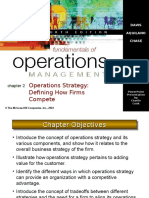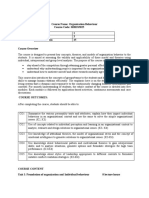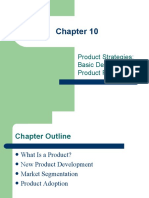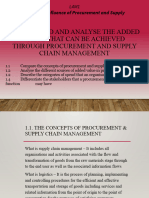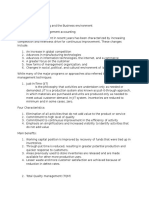CH01 - Introduction To Operations Management Rev.01
Uploaded by
Izzaty Riang RiaCH01 - Introduction To Operations Management Rev.01
Uploaded by
Izzaty Riang RiaIntroduction to Operations
Management
01
Compile by
Shukri Mohamed Salleh
Production and Operations Management
PPB 26304 / 23203
Historical Development of OM
Prior to 1900
Cottage industry produced custom-made goods.
Watts steam engine in 1785.
Whitneys standardized gun parts in 1801.
Industrial Revolution began at mid-century.
Historical Development of OM (cont.)
Scientific Management (Frederick W. Taylor)
Systematic approach to increasing worker productivity
through time study, standardization of work, and
incentives.
Viewed workers as an interchangeable asset.
Other Management Pioneers
Frank and Lillian Gilbreth
Motion study and industrial psychology
Henry L. Gantt
Scheduling and the Gantt chart
Historical Development of OM (cont.)
Moving Assembly Line (1913)
Labor specialization reduced assembly time.
Hawthorne Studies
Yielded unexpected results in the productivity of
Western Electric plant workers after changes in their
production environment.
Led to recognition of the importance of work design
and employee motivation.
Historical Development of OM (cont.)
Operations Research (Management Science)
Outgrowth of WWII needs for logistics control and
weapons-systems design.
Seeks to obtain mathematically optimal (quantitative)
solutions to complex problems.
OM Emerges as a Field
19501960, OM moved beyond industrial engineering
and operations research to the view of the production
operation as a system.
Historical Development of OM (cont.)
OM Emerges as a Field (contd)
19501960, OM moved beyond industrial engineering
and operations research to the view of the production
operation as a system.
The Marriage of OM and IT
Integrated solutions approaches
Business process reengineering
Supply chain management
Systems integration (SAP)
Historical Development of OM (cont.)
Operations Management in Services
OM concepts can apply to both manufacturing and
service operations.
Integration of Manufacturing and Services
Conducting world class operations requires compatible
manufacturing and service operations.
Historical Events in
Operations Management
Era Events/Concepts Dates Originator
Industrial
Revolution
Steam engine 1769
James Watt
Division of labor 1776
Adam Smith
Interchangeable parts 1790
Eli Whitney
Scientific
Management
Principles of scientific
management
1911
Frederick W. Taylor
Time and motion studies 1911
Frank and Lillian
Gilbreth
Activity scheduling chart 1912
Henry Gantt
Moving assembly line 1913
Henry Ford
Historical Events in
Operations Management
Era Events/Concepts Dates Originator
Human
Relations
Hawthorne studies 1930 Elton Mayo
Motivation theories
1940s Abraham Maslow
1950s Frederick Herzberg
1960s Douglas McGregor
Operations
Research
Linear programming 1947 George Dantzig
Digital computer 1951 Remington Rand
Simulation, waiting
line theory, decision
theory, PERT/CPM
1950s
Operations research
groups
MRP, EDI, EFT, CIM
1960s,
1970s
Joseph Orlicky, IBM
and others
Historical Events in
Operations Management
Era Events/Concepts Dates Originator
Quality
Revolution
JIT (just-in-time) 1970s Taiichi Ohno (Toyota)
TQM (total quality
management)
1980s
W. Edwards Deming,
Joseph Juran
Strategy and
operations
1980s
Wickham Skinner,
Robert Hayes
Reengineering 1990s
Michael Hammer,
James Champy
Six Sigma 1990s GE, Motorola
Historical Events in
Operations Management
Era Events/Concepts Dates Originator
Internet
Revolution
Internet, WWW, ERP,
supply chain management
1990s ARPANET, Tim
Berners-Lee SAP,
i2 Technologies,
ORACLE, Dell
E-commerce 2000s Amazon, Yahoo,
eBay, Google, and
others
Globalization WTO, European Union,
Global supply chains,
Outsourcing, Service
Science
1990s
2000s
China, India,
emerging
economies
Historical Events in
Operations Management
Era Events/Concepts Dates Originator
Green
Revolution
Global warming, An
Inconvenient Truth, Kyoto
Today Numerous
scientists,
statesmen and
governments
Evolution of Operations and
Supply Chain Management
Craft production
process of handcrafting products or services for
individual customers
Division of labor
dividing a job into a series of small tasks each
performed by a different worker
Interchangeable parts
standardization of parts initially as replacement parts;
enabled mass production
Evolution of Operations and
Supply Chain Management
Scientific management
systematic analysis of work methods
Mass production
high-volume production of a standardized product for
a mass market
Lean production
adaptation of mass production that prizes quality and
flexibility
Evolution of Operations and Supply
Chain Management
Supply chain management
management of the flow of information, products, and services across a
network of customers, enterprises, and supply chain partners
What Is Operations Management?
Operations Management
Management of the conversion process which
transforms inputs such as raw material and labor into
outputs in the form of finished goods and services.
Transformation Process
(components)
Inputs
(customers
and/or
materials)
Outputs
(goods
and
services)
Role of OM within an Organization
Top-down Approach to OM Strategy
Operations Strategy Decisions
Strategic (long-range)
Needs of customers
(capacity planning)
Tactical (medium-range)
Efficient scheduling of
resources
Operational planning
and control (short-range)
Immediate tasks and
activities
OM Focus Areas
Cost
Speed
Quality
Flexibility
Cost
Waste elimination
relentlessly pursuing the removal of all waste
Examination of cost structure
looking at the entire cost structure for reduction potential
Lean production
providing low costs through disciplined operations
Speed
Fast moves, Fast adaptations, Tight linkages
Internet
Customers expect immediate responses
Service organizations
always competed on speed (McDonalds, LensCrafters,
and Federal Express)
Manufacturers
time-based competition: build-to-order production and
efficient supply chains
Fashion industry
two-week design-to-rack lead time of Spanish retailer,
Zara
Quality
Minimizing defect rates or conforming to design
specifications
Ritz-Carlton - one customer at a time
Service system designed to move heaven and earth
to satisfy customer
Employees empowered to satisfy a guests wish
Teams set objectives and devise quality action plans
Each hotel has a quality leader
Flexibility
Ability to adjust to changes in product mix,
production volume, or design
Mass customization: the mass production of
customized parts
National Bicycle Industrial Company
offers 11,231,862 variations
delivers within two weeks at costs only 10% above
standard models
An Operational-Level OM Perspective
OMs function focuses on adding value through
the transformation process (technical core) of
converting inputs into outputs.
Physical: manufacturing
Locational: transportation
Exchange:retailing
Storage: warehousing
Physiological: health care
Informational: telecommunications
The Transformation Process within OM
Exhibit 1.2
Exhibit 1.3
Input-Transformation-Output Relationships
for Typical Systems
OMs Contributions to Society
Higher Standard of Living
Ability to increase productivity
Lower cost of goods and services
Better Quality Goods and Services
Competition increases quality
Concern for the Environment
Recycling and concern for air and water quality
Improved Working Conditions
Better job design and employee participation
Copyright 2005 The McGraw-Hill Companies. All rights reserved. McGraw-Hill/Irwin 128
The Emergence of OM
Operations management has been gaining
increased recognition in recent years for several
reasons, including
a) the application of OM concepts in service
operations,
b) an expanded definition of quality,
c) the introduction of OM concepts to other functional
areas such as marketing and human resources,
and
d) the realization that the OM function can add value
to the end product.
Good
The Emergence of OM (contd)
Application of OM to Service Operations
Batch cooking operations at McDonalds
Just-in-Time (JIT) at Northern Telecomm, Inc.
Automatic inventory replenishment at Wal-Mart
Service Product
Growth in Services in the United States
Exhibit 1.6
Source: Eva E. Jacobs, ed., Handbook of U.S. Labor Statistics,
5th ed. (Bernan Press, 2001), Table 2-1, pp. 161164.
1-6
Differences Between
Goods and Services
Goods
Tangible
Can be inventoried
No interaction
between customer
and process
Services
Intangible
Cannot be
inventoried
Direct interaction
between customer
and process
Exhibit 1.7
Most Products Are a Bundle
of Goods and Services
Exhibit 1.8
An Expanded Definition of Quality
Quality is important in all functional areas of an
organization.
Quality is now much more than the technical
requirements for manufactured goods.
Service quality (customer relationships)
is equally important.
Quality
A New Paradigm for OM
Post-War U.S. Dominance in Manufacturing
Available capacity built to support the war effort
Pent-up demand for consumer goods
Destruction of overseas production capabilities
Proactive Operations Function (Skinner)
Add value to products, increase profit margins.
Compete on dimensions other than costs:
Quality
Speed of delivery
Process flexibility
The Ever-Changing World of OM
Increased Global Competition
Transformation into a global economy
Pressure to excel on multiple
competitive dimensions
Increased emphasis on logistics
Advances in Technology
Information technology (IT)
Internet email and commerce (B2B)
Automation and robotics
Exhibit 1.9
Source: From Joseph E. Stiglitz, Principles of Micro-economics, 2nd ed. (New
York: W. W. Norton and Company, 1997), p. 58. Reprinted with permission.
Fords Global Network to Support
the Manufacturing of the Escort
Linking OM to Customers and Suppliers
Benefits of Buffering the Transformation Process
The process not disturbed by environmental
interaction.
The process was often more efficient than input and
distribution processes.
Productivity was maximized when processes operated
at continuous rates.
Process management skills were different from those
of other functional activities.
Linking OM to Customers and Suppliers
(contd)
Disadvantages of Buffering the Transformation
Process
Information lag in interaction with other functional
activities.
Lack of communication between customers and the
shop floor for problem solving.
Linking OM to Customers and Suppliers
(contd)
Value Chain
Steps an organization requires to produce a good or
a service regardless of where they are performed.
Virtual enterprises: fully integrated and interlocked
networks of interdependent companies.
Outsourcing Offshore
Jobs are now outsourced worldwide.
Originally outsourcing involved primarily
manufacturing jobs; increases in technology now
allow the outsourcing of white collar jobs.
The Value Chain and
Its Support Functions
Exhibit 1.10
Line and Staff Jobs in OM
Exhibit 1.11
Inputs Provided by OM to
Other Functional Areas
Exhibit 1.11
Reference
Davis, M. and Heineke, J., 2005, Operations
Management : Integrating Manufacturing and
Services, McGraw-Hill Companies Inc. Fifth Ed.
Russell, R. and Taylor B., 2011, Operations
Management: Creating Value Along the Supply
Chain, Jon Wiley & Sons, Sixth Ed.
Chase, R. et al, 2006, Operation Management for
Competitive Advantages, McGraw-Hill Companies
Inc. 11th Ed.
You might also like
- 2014 New York Fashion Week Sponsorship PDF100% (6)2014 New York Fashion Week Sponsorship PDF12 pages
- Lecture 02 Operations Mangement Objectives100% (1)Lecture 02 Operations Mangement Objectives14 pages
- Unit-I Introduction To Operations ManagementNo ratings yetUnit-I Introduction To Operations Management55 pages
- The Role of Technology in Operations: F O U R T H E D I T I O N100% (1)The Role of Technology in Operations: F O U R T H E D I T I O N25 pages
- Chapter 6: Setting and Implementing: Prices Revenue ManagementNo ratings yetChapter 6: Setting and Implementing: Prices Revenue Management29 pages
- Handouts Vertical and Horizontal AnalysisNo ratings yetHandouts Vertical and Horizontal Analysis2 pages
- Operations Strategy: Defining How Firms Compete: F O U R T H E D I T I O NNo ratings yetOperations Strategy: Defining How Firms Compete: F O U R T H E D I T I O N29 pages
- Introduction To Revenue Management: by Bijoy-Gaurav SenguptaNo ratings yetIntroduction To Revenue Management: by Bijoy-Gaurav Sengupta13 pages
- Unit 1: Introduction To Operations ManagementNo ratings yetUnit 1: Introduction To Operations Management37 pages
- MGT4B Human Resource Management SyllabusNo ratings yetMGT4B Human Resource Management Syllabus10 pages
- FABM 1 Lesson-3-Users-of-Accounting-InformationNo ratings yetFABM 1 Lesson-3-Users-of-Accounting-Information2 pages
- Gathering Information and Scanning The Environment: Marketing Management100% (1)Gathering Information and Scanning The Environment: Marketing Management31 pages
- CAPACITY PLANNING, DECISION THEORY, PROCESS SELECTION AND FACILITY LAYOUT and LINEAR PROGRAMMINGNo ratings yetCAPACITY PLANNING, DECISION THEORY, PROCESS SELECTION AND FACILITY LAYOUT and LINEAR PROGRAMMING14 pages
- International Marketing: Pesented By: Deepak Khandelwal Pesented By: Deepak KhandelwalNo ratings yetInternational Marketing: Pesented By: Deepak Khandelwal Pesented By: Deepak Khandelwal24 pages
- Torrington, Hall & Taylor, Human Resource Management 6e, © Pearson Education Limited 20050% (1)Torrington, Hall & Taylor, Human Resource Management 6e, © Pearson Education Limited 200527 pages
- 1851 - Capter 3 Job Order Costing Tanpa EdisiNo ratings yet1851 - Capter 3 Job Order Costing Tanpa Edisi47 pages
- Product Strategies: Basic Decisions & Product PlanningNo ratings yetProduct Strategies: Basic Decisions & Product Planning24 pages
- The Dynamic Environment of Human Resource Management (HRM)100% (1)The Dynamic Environment of Human Resource Management (HRM)14 pages
- Scope & Influence of Procurement and Supply - L4M1 (2109) PPT SLIDESNo ratings yetScope & Influence of Procurement and Supply - L4M1 (2109) PPT SLIDES107 pages
- Immediate download Looking at Logistics A Practical Introduction to Logistics and Supply Chain Management 3rd Edition Philip Price ebooks 2024100% (8)Immediate download Looking at Logistics A Practical Introduction to Logistics and Supply Chain Management 3rd Edition Philip Price ebooks 202467 pages
- Chapter 1: Exploring The World of Business and EconomicsNo ratings yetChapter 1: Exploring The World of Business and Economics7 pages
- Assessing A New Venture's Financial Strength and Viability: Bruce R. Barringer R. Duane IrelandNo ratings yetAssessing A New Venture's Financial Strength and Viability: Bruce R. Barringer R. Duane Ireland195 pages
- CH 4 The Search For A Sound Business IdeasNo ratings yetCH 4 The Search For A Sound Business Ideas23 pages
- Ethics Issue in Capitalism and Market System: Submitted By: Prashant Maharshi ISBE/PGP/SS/2011-13No ratings yetEthics Issue in Capitalism and Market System: Submitted By: Prashant Maharshi ISBE/PGP/SS/2011-1321 pages
- Term End Examination - November 2014 Course: MEE437 - Operations Research Slot: G2+TG2 Class NBR: 5692 Time: Three Hours Max - Marks:100No ratings yetTerm End Examination - November 2014 Course: MEE437 - Operations Research Slot: G2+TG2 Class NBR: 5692 Time: Three Hours Max - Marks:1003 pages
- Production, Operations & Materials Management: Syllabus in BriefNo ratings yetProduction, Operations & Materials Management: Syllabus in Brief52 pages
- Activity Based Costing - An IntroductionNo ratings yetActivity Based Costing - An Introduction40 pages
- Restaurant Catering Suppliers Guide 2017No ratings yetRestaurant Catering Suppliers Guide 201736 pages
- 5C Analysis: Collaborators Customers Competitors ContextNo ratings yet5C Analysis: Collaborators Customers Competitors Context5 pages
- 261059364unit 6 Warehousing and Material HandlingNo ratings yet261059364unit 6 Warehousing and Material Handling12 pages
- Waste Reduction in Fresh Food Supply ChainsNo ratings yetWaste Reduction in Fresh Food Supply Chains8 pages
- CICI Securities LTD Is An Integrated Securities Firm Offering A Wide Range of Services Including Investment BankingNo ratings yetCICI Securities LTD Is An Integrated Securities Firm Offering A Wide Range of Services Including Investment Banking5 pages
- Program Pembangunan Pembekal Mapan - Aeon Co. (M) BHDNo ratings yetProgram Pembangunan Pembekal Mapan - Aeon Co. (M) BHD20 pages
- Content Extraction From Marketing Flyers: (Ignazio - Gallo, A.zamberletti, Lucia - Noce) @uninsubria - ItNo ratings yetContent Extraction From Marketing Flyers: (Ignazio - Gallo, A.zamberletti, Lucia - Noce) @uninsubria - It2 pages
- Supply Chain Management at World Co PPT Slides100% (1)Supply Chain Management at World Co PPT Slides16 pages
- Organizational Structure of Retail Firm Dr. Anitha Prasad100% (2)Organizational Structure of Retail Firm Dr. Anitha Prasad26 pages
- The Role of Technology in Operations: F O U R T H E D I T I O NThe Role of Technology in Operations: F O U R T H E D I T I O N
- Chapter 6: Setting and Implementing: Prices Revenue ManagementChapter 6: Setting and Implementing: Prices Revenue Management
- Operations Strategy: Defining How Firms Compete: F O U R T H E D I T I O NOperations Strategy: Defining How Firms Compete: F O U R T H E D I T I O N
- Introduction To Revenue Management: by Bijoy-Gaurav SenguptaIntroduction To Revenue Management: by Bijoy-Gaurav Sengupta
- Gathering Information and Scanning The Environment: Marketing ManagementGathering Information and Scanning The Environment: Marketing Management
- CAPACITY PLANNING, DECISION THEORY, PROCESS SELECTION AND FACILITY LAYOUT and LINEAR PROGRAMMINGCAPACITY PLANNING, DECISION THEORY, PROCESS SELECTION AND FACILITY LAYOUT and LINEAR PROGRAMMING
- International Marketing: Pesented By: Deepak Khandelwal Pesented By: Deepak KhandelwalInternational Marketing: Pesented By: Deepak Khandelwal Pesented By: Deepak Khandelwal
- Torrington, Hall & Taylor, Human Resource Management 6e, © Pearson Education Limited 2005Torrington, Hall & Taylor, Human Resource Management 6e, © Pearson Education Limited 2005
- Product Strategies: Basic Decisions & Product PlanningProduct Strategies: Basic Decisions & Product Planning
- The Dynamic Environment of Human Resource Management (HRM)The Dynamic Environment of Human Resource Management (HRM)
- Scope & Influence of Procurement and Supply - L4M1 (2109) PPT SLIDESScope & Influence of Procurement and Supply - L4M1 (2109) PPT SLIDES
- Immediate download Looking at Logistics A Practical Introduction to Logistics and Supply Chain Management 3rd Edition Philip Price ebooks 2024Immediate download Looking at Logistics A Practical Introduction to Logistics and Supply Chain Management 3rd Edition Philip Price ebooks 2024
- Chapter 1: Exploring The World of Business and EconomicsChapter 1: Exploring The World of Business and Economics
- Assessing A New Venture's Financial Strength and Viability: Bruce R. Barringer R. Duane IrelandAssessing A New Venture's Financial Strength and Viability: Bruce R. Barringer R. Duane Ireland
- Ethics Issue in Capitalism and Market System: Submitted By: Prashant Maharshi ISBE/PGP/SS/2011-13Ethics Issue in Capitalism and Market System: Submitted By: Prashant Maharshi ISBE/PGP/SS/2011-13
- Term End Examination - November 2014 Course: MEE437 - Operations Research Slot: G2+TG2 Class NBR: 5692 Time: Three Hours Max - Marks:100Term End Examination - November 2014 Course: MEE437 - Operations Research Slot: G2+TG2 Class NBR: 5692 Time: Three Hours Max - Marks:100
- Production, Operations & Materials Management: Syllabus in BriefProduction, Operations & Materials Management: Syllabus in Brief
- Intellectual Capital Complete Self-Assessment GuideFrom EverandIntellectual Capital Complete Self-Assessment Guide
- 5C Analysis: Collaborators Customers Competitors Context5C Analysis: Collaborators Customers Competitors Context
- CICI Securities LTD Is An Integrated Securities Firm Offering A Wide Range of Services Including Investment BankingCICI Securities LTD Is An Integrated Securities Firm Offering A Wide Range of Services Including Investment Banking
- Program Pembangunan Pembekal Mapan - Aeon Co. (M) BHDProgram Pembangunan Pembekal Mapan - Aeon Co. (M) BHD
- Content Extraction From Marketing Flyers: (Ignazio - Gallo, A.zamberletti, Lucia - Noce) @uninsubria - ItContent Extraction From Marketing Flyers: (Ignazio - Gallo, A.zamberletti, Lucia - Noce) @uninsubria - It
- Organizational Structure of Retail Firm Dr. Anitha PrasadOrganizational Structure of Retail Firm Dr. Anitha Prasad










